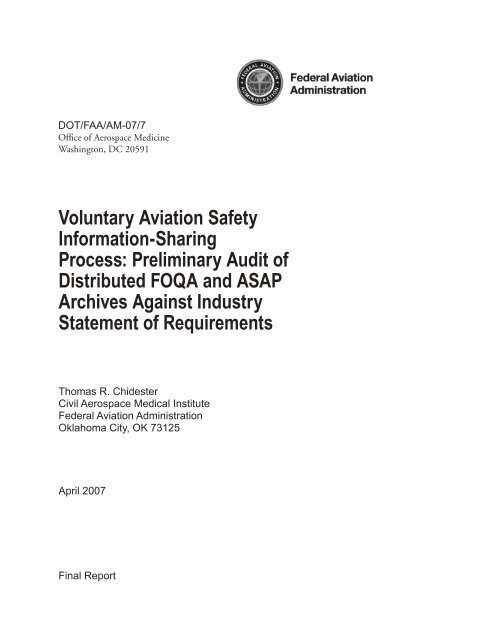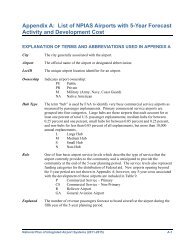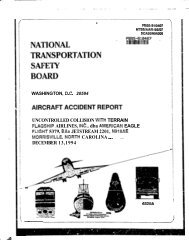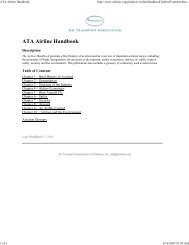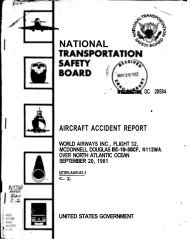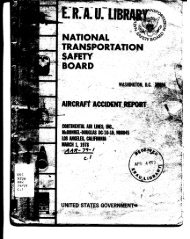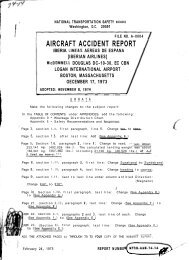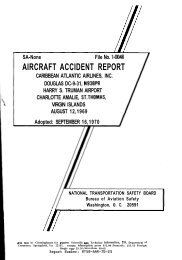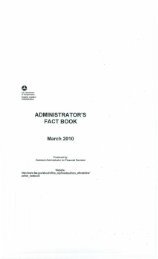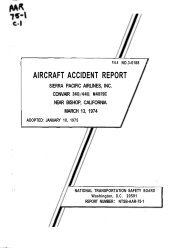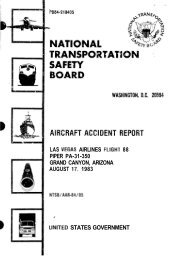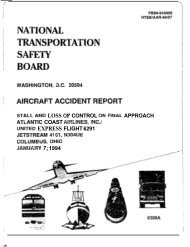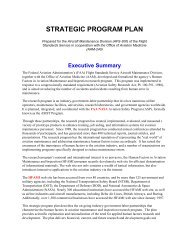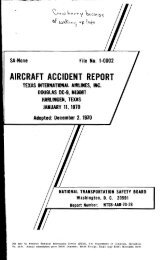Voluntary Aviation Safety Information-Sharing Process - Defense ...
Voluntary Aviation Safety Information-Sharing Process - Defense ...
Voluntary Aviation Safety Information-Sharing Process - Defense ...
You also want an ePaper? Increase the reach of your titles
YUMPU automatically turns print PDFs into web optimized ePapers that Google loves.
DOT/FAA/AM-07/7<br />
Office of Aerospace Medicine<br />
Washington, DC 20591<br />
<strong>Voluntary</strong> <strong>Aviation</strong> <strong>Safety</strong><br />
<strong>Information</strong>-<strong>Sharing</strong><br />
<strong>Process</strong>: Preliminary Audit of<br />
Distributed FOQA and ASAP<br />
Archives Against Industry<br />
Statement of Requirements<br />
Thomas R. Chidester<br />
Civil Aerospace Medical Institute<br />
Federal <strong>Aviation</strong> Administration<br />
Oklahoma City, OK 73125<br />
April 2007<br />
Final Report
NOTICE<br />
This document is disseminated under the sponsorship<br />
of the U.S. Department of Transportation in the interest<br />
of information exchange. The United States Government<br />
assumes no liability for the contents thereof.<br />
___________<br />
This publication and all Office of Aerospace Medicine<br />
technical reports are available in full-text from the Civil<br />
Aerospace Medical Institute’s publications Web site:<br />
www.faa.gov/library/reports/medical/oamtechreports/index.cfm
Technical Report Documentation Page<br />
1. Report No. 2. Government Accession No. 3. Recipient's Catalog No.<br />
DOT/FAA/AM-07/7<br />
4. Title and Subtitle 5. Report Date<br />
<strong>Voluntary</strong> <strong>Aviation</strong> <strong>Safety</strong> <strong>Information</strong>-<strong>Sharing</strong> <strong>Process</strong>: Preliminary Audit<br />
of Distributed FOQA and ASAP Archives Against Industry Statement of<br />
Requirements<br />
i<br />
April 2007<br />
6. Performing Organization Code<br />
7. Author(s) 8. Performing Organization Report No.<br />
Chidester TR<br />
9. Performing Organization Name and Address 10. Work Unit No. (TRAIS)<br />
FAA Civil Aerospace Medical Institute<br />
P.O. Box 25082 11. Contract or Grant No.<br />
Oklahoma City, OK 73125<br />
12. Sponsoring Agency name and Address 13. Type of Report and Period Covered<br />
Office of Aerospace Medicine<br />
Federal <strong>Aviation</strong> Administration<br />
800 Independence Ave., S.W.<br />
Washington, DC 20591 14. Sponsoring Agency Code<br />
15. Supplemental Notes<br />
Work was accomplished under approved task AM-AHRR521<br />
16. Abstract<br />
The <strong>Voluntary</strong> <strong>Aviation</strong> <strong>Safety</strong> <strong>Information</strong>-<strong>Sharing</strong> <strong>Process</strong> (VASIP) is designed to provide a means for the<br />
commercial aviation industry and the Federal <strong>Aviation</strong> Administration (FAA) to collect, share safety-related<br />
information, and to use that information to proactively identify, analyze, and correct safety issues that affect<br />
commercial aviation. The key to VASIP is the development of a technical process to extract de-identified safety<br />
data from any participating airline Flight Operations Quality Assurance (FOQA) or <strong>Aviation</strong> <strong>Safety</strong> Action<br />
Program (ASAP), aggregate it through a distributed database, and make it accessible to appropriate industry<br />
stakeholders for analysis. In 2004, the ASAP and FOQA <strong>Aviation</strong> Rulemaking Committees (ARCs) identified<br />
the National Aeronautics and Space Administration (NASA) as having the institutional background, resources,<br />
and personnel capable of developing this technical aggregation framework, as well as the analytical tools to<br />
support the process. Beginning in June of 2004, NASA led a collaborative partnership of participating airlines,<br />
employee organizations, and FAA representatives to define key components of archives of FOQA and ASAP<br />
data. This defined a set of functional requirements for archive development that were approved by the FOQA<br />
and ASAP ARCs. In October 2004, at the request of and with partial funding by the FAA, NASA initiated an<br />
<strong>Information</strong> <strong>Sharing</strong> Initiative under the <strong>Aviation</strong> <strong>Safety</strong> and Security Program to provide funds and oversight to<br />
develop distributed archiving and analysis. The basic infrastructure was deployed in January 2006, and data<br />
archiving began at participating airlines. The current document audits the hardware, software, and networking<br />
infrastructure against the original functional specifications provided by the ARCs to NASA.<br />
17. Key Words 18. Distribution Statement<br />
<strong>Information</strong> <strong>Sharing</strong>, Flight Data, <strong>Safety</strong> Reports<br />
Document is available to the public through the<br />
<strong>Defense</strong> Technical <strong>Information</strong> Center, Ft. Belvior, VA<br />
22060; and the National Technical <strong>Information</strong><br />
Service, Springfield, VA 22161<br />
19. Security Classif. (of this report) 20. Security Classif. (of this page) 21. No. of Pages 22. Price<br />
Unclassified Unclassified 14<br />
Form DOT F 1700.7 (8-72) Reproduction of completed page authorized
LIsT Of ACrONyms UsEd IN ThIs dOCUmENT<br />
ARC ............ <strong>Aviation</strong> Rulemaking Committee<br />
ASAP ........... <strong>Aviation</strong> <strong>Safety</strong> Action Program<br />
CAST .......... Commercial <strong>Aviation</strong> <strong>Safety</strong> Team<br />
DAWG ........ Data Aggregation Working Group<br />
DNAA ......... Distributed National ASAP Archive<br />
DNFA ......... Distributed National FOQA Archive<br />
ESC ............. Executive Steering Committee<br />
FAA ............. Federal <strong>Aviation</strong> Administration<br />
FOQA ......... Flight Operations Quality Assurance<br />
NASA .......... National Aeronautics and Space Administration<br />
RPS ............. Rules and Procedures Subcommittee<br />
VASIP .......... <strong>Voluntary</strong> <strong>Aviation</strong> <strong>Safety</strong> <strong>Information</strong>-<strong>Sharing</strong> <strong>Process</strong><br />
VSIS ............ <strong>Voluntary</strong> <strong>Safety</strong> <strong>Information</strong> <strong>Sharing</strong><br />
iii
<strong>Voluntary</strong> aViation <strong>Safety</strong> information-<strong>Sharing</strong> ProceSS:<br />
Preliminary audit of diStributed foQa and aSaP archiVeS<br />
againSt induStry Statement of reQuirementS<br />
I. INTrOdUCTION<br />
The <strong>Voluntary</strong> <strong>Aviation</strong> <strong>Safety</strong> <strong>Information</strong>-<strong>Sharing</strong><br />
<strong>Process</strong> (VASIP) is designed to provide a means for the<br />
commercial aviation industry and the Federal <strong>Aviation</strong><br />
Administration (FAA) to collect, share safety-related<br />
information, and to use that information to proactively<br />
identify, analyze, and correct safety issues that affect<br />
commercial aviation.<br />
The key to VASIP is the development of a technical<br />
process to extract de-identified safety data from any<br />
participating airline Flight Operations Quality Assurance<br />
(FOQA) or <strong>Aviation</strong> <strong>Safety</strong> Action Program (ASAP),<br />
aggregate it through a distributed database, and make<br />
it accessible to appropriate industry stakeholders for<br />
analysis.<br />
In 2004, the ASAP and FOQA <strong>Aviation</strong> Rulemaking<br />
Committees (ARCs) identified the National Aeronautics<br />
and Space Administration (NASA) as having the institutional<br />
background, resources, and personnel capable of<br />
developing this technical aggregation framework, as well<br />
as the analytical tools to support the process. Beginning<br />
in June of 2004, NASA led a collaborative partnership of<br />
participating airlines, employee organizations, and FAA<br />
representatives to define key components of archives of<br />
FOQA and ASAP data. This defined a set of functional<br />
requirements for archive development that were approved<br />
by the FOQA and ASAP ARCs. In October 2004, at the<br />
request of and with partial funding by the FAA, NASA<br />
initiated an <strong>Information</strong> <strong>Sharing</strong> Initiative under the <strong>Aviation</strong><br />
<strong>Safety</strong> and Security Program to provide funds and<br />
oversight to develop distributed archiving and analysis.<br />
The basic infrastructure was deployed in January 2006,<br />
and data archiving began at participating airlines. In<br />
January 2006, the ASAP and FOQA ARCs were replaced<br />
by the <strong>Voluntary</strong> <strong>Safety</strong> <strong>Information</strong> <strong>Sharing</strong> (VSIS)<br />
ARC, which was tasked to oversee distributed archive<br />
operation and expansion, data analysis and reporting<br />
using the archives, and advocacy of solutions to problems<br />
and issues discovered and understood through the data<br />
sharing process.<br />
The author was tasked under FAA Program Directive<br />
081500001, Task FD-10, to review the functionality of<br />
the Distributed National FOQA Archive (DNFA) and<br />
Distributed National ASAP Archive (DNAA) relative to<br />
the specifications provided by the FOQA and ASAP ARCs.<br />
1<br />
The current document audits the hardware, software, and<br />
networking infrastructure against the original functional<br />
specifications provided by the ARCs to NASA. Auditing<br />
was accomplished by monitoring NASA’s functional testing<br />
and demonstration of archive hardware and software<br />
from November 2005 though April 2006, and during a<br />
site visit in May 2006 to review functions that had not<br />
been demonstrated at previous meetings.<br />
A distinction must be drawn between an audit of functionalities<br />
specified by the ARCs and an audit against the<br />
System Requirements Document developed by Battelle<br />
and its subcontractors and presented to NASA in 2005.<br />
The former asks whether the system accomplishes the tasks<br />
requested by the ARC; the latter is a matter of formal verification<br />
that the system was built to its detailed specifications.<br />
This report is the former; NASA has undertaken the latter<br />
through its contracting and oversight processes.<br />
II. TEChNICAL rEqUIrEmENTs<br />
distributed National fOqA Archive<br />
Overview. The VASIP Executive Steering Committee<br />
(ESC), representatives from airline, union, FAA, and the<br />
FOQA and ASAP ARCs, asked NASA to develop and<br />
implement hardware, software, and networking for a<br />
distributed-concept archive of industry flight data and<br />
safety reports. The committee proposed that NASA and<br />
the FAA jointly fund a two-year demonstration project,<br />
implemented to a sufficient level of reliability that it may<br />
be continued by any selected operating organization.<br />
For flight data, NASA was asked to implement a<br />
network of servers located on airline premises and access<br />
local servers via the network for aggregation, statistical<br />
analysis, and summarization in response to ESC requests.<br />
Figure 1 shows that local servers receive de-identified flight<br />
parameters at measured rates, pushed from each airline’s<br />
FOQA-analysis machine to the local archive server. In<br />
response to ESC-approved requests, queries are sent from<br />
a central server and accomplished on each local server.<br />
Figure 2 shows how analysis results are forwarded via the<br />
network to a central server at NASA Ames, and aggregate<br />
result summaries in electronic format returned to each<br />
airline’s local server and forwarded to analysis working<br />
groups assigned by the ESC. Notice that data are “pushed”<br />
to the local archive server and information, in the form<br />
of query results, is “pulled” to the central server.
Figure 1. Querying Distributed archives<br />
Figure 2. Analyzing Query Results<br />
2
This allows the analysis working groups and ESC to<br />
assess problems of a national scope rather than individual<br />
events and operators. Each airline can compare its results<br />
with archive results, focusing any corrective actions at an<br />
appropriate level.<br />
Functionality. Functionality for the demonstration<br />
project was limited to the functions described below,<br />
but NASA was asked to design the archive, network,<br />
and software to enable future growth in both number<br />
of airlines networked and analytic capability, and select<br />
hardware accordingly. At the completion of the program,<br />
the network must be capable of accommodating 50 total<br />
combined FOQA and ASAP program servers. The ARC<br />
specified these functions:<br />
• The ability to search across local servers for flights<br />
experiencing defined events. All search activities will<br />
be logged on each local server for review by the airline<br />
owner of the data.<br />
• The ability to calculate aggregate distributions for<br />
snapshots at any point in flight, which implies abilities<br />
to:<br />
– derive new or composite parameters from recorded<br />
values,<br />
– calculate statistics and display parameter and statistical<br />
distributions at or between any points in<br />
flight, and<br />
– include weather information, where recorded by<br />
vendor.<br />
• The ability to view parameter traces of selected individual<br />
flights on their local server without moving the<br />
data to the central server.<br />
• The ability to export selected parameters from selected<br />
flights to airspace visualization tools (i.e., traffic or -D<br />
trajectory) so that the track of individual flights or a<br />
selected sample of flights can be viewed within their<br />
airspace of operation.<br />
A more detailed specification of functionality was<br />
provided by NASA to Battelle in November of 2004.<br />
The functional audit was organized around the more<br />
detailed specification.<br />
<strong>Process</strong>ing. The archive was built using distributed<br />
databases. NASA was asked to construct a network of<br />
servers located on airline premises to be accessed by NASA<br />
for aggregation, statistical analysis, and summarization. At<br />
each airline, selected, de-identified parameters at measured<br />
rates are pushed by the airline’s FOQA-vendor analysis<br />
machine to the local archive server following completion<br />
of airline validation procedures. NASA was also asked to<br />
contract with vendors serving airlines participating in<br />
the DNFA to determine the format of data transferred<br />
to the local archive server, create the necessary software,<br />
and accomplish these services in a manner consistent<br />
with Federal Acquisition Regulations. The FOQA Data<br />
Aggregation Working Group (DAWG), chartered by the<br />
FOQA ARC, recommended the final list of parameters,<br />
which was approved by the VSIS ARC Rules and Procedures<br />
Sub-committee (RPS) and ESC. Downloaded data<br />
remain on the airlines’ premises. Each flight would be deidentified<br />
so as to retain only month of flight, departure<br />
and arrival airports and runways, and aircraft model.<br />
Hardware. Hardware specifications were deferred<br />
to the recommendations of NASA and its contractors<br />
and/or grantees. Redundant storage was specified to<br />
maintain two years’ data on the local archive server at<br />
each airline. Discussions with the airlines further specified<br />
that local servers require minimal maintenance by each<br />
airline, essentially no more than the occasional re-boot<br />
by airline personnel.<br />
Software. NASA was asked to develop all software<br />
necessary to the archive functions, making use of commercially-available<br />
software where practical, but not<br />
favoring any single FOQA-vendor.<br />
Networking. NASA was asked to provide a secure<br />
network of T-1 (or better) lines connecting each local<br />
server to the central server at NASA Ames and to other<br />
ESC-approved nodes. Security performance in compliance<br />
with NASA Business and Restricted Technology (BRT)<br />
was specified; those standards were superseded during<br />
archive development and NASA complied with both the<br />
new set of standards and local requirements imposed by<br />
individual airlines.<br />
distributed National AsAP Archive<br />
Overview. For safety reports submitted to airline ASAP<br />
programs, NASA was asked to implement a network of<br />
servers enabling de-identified information from multiple<br />
databases to be queried for aggregation, statistical analysis,<br />
and summarization in response to ESC requests. This<br />
network includes an archive server on each airline’s premises,<br />
where de-identified data are housed, and a central<br />
server at NASA Ames Research Center, where queries<br />
are generated and summary results aggregated. NASA<br />
has also provided a server and network node to a grantee<br />
(University of Texas at Austin) designated to accomplish<br />
queries and aggregation requested by the ESC, and has<br />
delegated ASAP processing to that server. De-identified<br />
ASAP reports are pushed from the airline’s ASAP server<br />
to the local archive server using software provided by<br />
NASA and its primary contractor, Battelle. This software<br />
creates a common format of categorized data derived from<br />
the submission and processing of ASAP reports at the<br />
airline level by mapping the airline’s existing reporting<br />
and analysis system to a common taxonomic set.
Functionality. Functionality for the demonstration<br />
project was limited to functions described below, but<br />
NASA was asked to design the archive, network, hardware,<br />
and software to enable future growth in both number of<br />
airlines networked and analytic capability. The following<br />
functions were specified:<br />
• The ability to search across local servers for ASAPreported<br />
events based on categorized field searches.<br />
• The ability to calculate distributions for categorizations,<br />
which implies abilities to:<br />
– derive new or composite categories or fields from<br />
ASAP report fields, and<br />
– calculate statistics and display categorization and statistical<br />
distributions based on ASAP report fields.<br />
<strong>Process</strong>ing. The DNAA is based on mapping ASAP<br />
data fields from participating carriers to a common format<br />
archive data structure. An ASAP Data Aggregation<br />
Working Group was appointed by the ASAP ARC to<br />
define fields and categories to be included or mapped to<br />
a common format for the archive. Airlines may choose<br />
to use formats built by NASA and its contractors for<br />
reporting, analysis, or tracking. Alternatively, airlines<br />
may participate by mapping the airline’s existing reporting<br />
and analysis system to common fields, and pushing<br />
their data to the local archive server. Each ASAP report<br />
on the local archive server is de-identified so as to retain<br />
only month of flight, departure and arrival airports, and<br />
aircraft model.<br />
Hardware. NASA selected DNAA hardware similar<br />
to DNFA. In the case of the DNAA, specifications that<br />
local servers require minimal maintenance by each airline,<br />
essentially no more than the occasional re-boot by<br />
airline personnel, resulted in significantly more capable<br />
and costly machines than were necessary to complete<br />
the archive functions alone. Were maintenance provided<br />
by participating airlines, the cost of ASAP servers could<br />
be greatly reduced, and this needs to be considered for<br />
deployment of future airlines. The maintenance requirement<br />
drove a higher cost than may be necessary for future<br />
installations.<br />
III. ImPLEmENTATION sTATUs<br />
Status Report from NASA. On May 9, 2006, NASA<br />
Project Lead Irving Statler reported:<br />
The status of the DNFA and the DNAA as of the end of<br />
April is that the system is operational, test queries have been<br />
conducted, and the system is ready for operational queries<br />
as directed by the VASIP ESC.<br />
4<br />
The following is the status of current participating air carriers:<br />
Alaska DNFA only <strong>Process</strong>ing data<br />
American DNAA only <strong>Process</strong>ing data<br />
Continental DNFA & DNAA<br />
Active – no DNFA data<br />
feed<br />
Delta DNFA only <strong>Process</strong>ing data<br />
Frontier DNAA only <strong>Process</strong>ing data<br />
JetBlue DNFA only <strong>Process</strong>ing data<br />
Southwest DNFA <strong>Process</strong>ing data<br />
United DNFA (DNAA ’06) <strong>Process</strong>ing data<br />
UPS DNFA only <strong>Process</strong>ing data<br />
ExpressJet DNFA & DNAA<br />
SAA completed, hardware<br />
on order<br />
On April 10, 2006, a live demonstration of the archives was<br />
presented to representatives of the VSIS ARC and other key<br />
FAA personnel at a meeting hosted by JetBlue Airlines in<br />
New York. It was also presented to the ATA <strong>Safety</strong> Council<br />
in Washington, and to the Commercial <strong>Aviation</strong> <strong>Safety</strong> Team<br />
(CAST), to the <strong>Information</strong> <strong>Sharing</strong> meeting, and to the<br />
“Shared Vision of <strong>Aviation</strong> <strong>Safety</strong>” Conference in Denver<br />
using movies of the live demo where there was no node for<br />
connection into the secure network.<br />
The ISI Team provided a status report of the DNFA and the<br />
DNAA to the VSIS ARC at its meeting on April 20, 2006.<br />
DNFA:<br />
• The final code was completed to adapt the World Wind KML<br />
event-display for use as the primary flight track and event<br />
display tool to support the DNFA reporting function. ATC Sector<br />
and Center boundary data are not yet available to NASA<br />
to support the desired flight-track displays in World Wind flight<br />
track. A request has been made to the FAA for access to this<br />
information.<br />
• DNFA data are now being processed into the archives at five<br />
airlines at a rate of approximately 50,000 flights per month. The<br />
total number of flights in the distributed archives by the end of<br />
April was well over 200,000.<br />
• United Airlines is now connected to the DNFA network, but<br />
we are still waiting on the resolution of final network setup<br />
configuration issues at United before the data will transfer to<br />
the NASA local server.<br />
•<br />
Testing of all DNFA tools and systems are ongoing with demonstrated<br />
improvements to system reliability and efficiency.<br />
Additional functionalities and capabilities that were not demonstrated<br />
at the JetBlue meeting are being validated and tested.
•<br />
These will be delivered with the required system stabilization<br />
by 31 May.<br />
A change was proposed to the VSIS/VASIP P&O document<br />
which would allow NASA and Battelle direct access to the<br />
DNFA network for development of a demonstration of an<br />
adaptation of the Morning Report for use with the DNFA. That<br />
new language was approved by the ARC at the April meeting.<br />
No .ffd files will be moved to the Central node; however, meta<br />
statistical data and processed data such as Flight Signatures<br />
and Intermediate Values may be returned to and accessed<br />
from the Central server.<br />
DNAA:<br />
• Archive hardware for four participating airlines has been activated<br />
and delivered. Support has been provided to these airlines to<br />
complete installation, network configuration, and testing at the<br />
local archive level. One of these four airlines will start actively<br />
pushing data to the DNAA pending the release of a new ASAP<br />
reporting tool. An additional 2 airlines are preparing for participation<br />
in the DNAA in 2006.<br />
• All DNAA networks, central servers, airline nodes, and software<br />
are working properly. System testing is on-going.<br />
• The DNAA Master List has been mapped to 6 unique airline and<br />
vendor formats. This mapping was completed in preparation<br />
for additional airline participation in the DNAA. The initial four<br />
participating airlines are currently categorizing their ASAP data<br />
using the DNAA Master List.<br />
• A full referenced-based data dictionary is under development<br />
to support the DNAA Master List.<br />
• The DNAA network contains approximately 2500 reports. Three<br />
airlines are currently providing data to the DNAA at a rate of<br />
225 to 250 per month. It is predicted that with the participation<br />
of the three additional airlines schedule for implementation in<br />
2006, the monthly rate will increase to approximately 650 per<br />
month.<br />
Audit of functionality. On November 4, 2005,<br />
NASA conducted a preliminary demonstration of archive<br />
capabilities for representatives of the VASIP ESC<br />
at Battelle’s facilities in Mountain View, CA. The DNFA<br />
demonstration was live, using samples of data from three<br />
airlines on local archive servers both present in Mountain<br />
View and remote at a sub-contractor’s (ProWorks) facility.<br />
This allowed a full demonstration of functionality with<br />
a limited sample of data. The DNAA demonstration<br />
used test data residing on four archive servers present<br />
in Mountain View. This demonstration represented full<br />
functionality of the DNAA with test data.<br />
At the full demonstration of both the DNFA and<br />
DNAA from the local archive server at JetBlue Airlines<br />
in Queens, New York, data were accessed from the five<br />
on-line airlines (of seven participating) for the DNFA<br />
and three airlines participating in the DNAA.<br />
5<br />
On May 10-11, 2006, the author traveled to Battelle’s<br />
facilities in Mountain View to review functions that had<br />
not been demonstrated at the November 2005 and April<br />
2006 meetings. This allowed review of functionalities as<br />
follows:<br />
dNfA<br />
• Software architecture specifications. A system architecture<br />
design document was delivered to NASA<br />
by Battelle and its subcontractors on February 15,<br />
2005.<br />
• Server specifications. Detailed specifications for all<br />
servers were delivered to NASA by Battelle on March 4,<br />
2005. All specified hardware was purchased by NASA,<br />
assembled by Battelle, and delivered to participating<br />
airlines in January 2006.<br />
• Generic parameter list. The FOQA DAWG agreed<br />
upon a standard list of 99 parameters that the DNFA<br />
will accept from any participating airline’s aircraft at<br />
each parameter’s native sampling rate. Aircraft are not<br />
required to record all parameters to be included; the<br />
archive accepts those parameters recorded and indicates<br />
missing values for all others. However, searches cannot<br />
make use of data from aircraft on which search criterion<br />
values are missing. The archive automatically derives<br />
an additional 5 parameters during initial processing<br />
on each local archive server where the underlying<br />
parameters are available.<br />
• Standard data format. Battelle, SAGEM Avionics,<br />
and Austin Digital, Inc. agreed upon a standard data<br />
format for transfer from vendor FOQA machines to<br />
the local archive servers. Initial documentation of this<br />
format was delivered to NASA by Battelle on February<br />
2 2005. A final version was delivered on September<br />
12, 2005.<br />
•<br />
Transfer of data from FOQA vendor machines to<br />
local archive server. Transfer of data was initiated at<br />
four airlines by SAGEM Avionics beginning January<br />
1, 2006. Transfer was initiated at one airline by Austin<br />
Digital, Inc., beginning January 1, 2006. Due to<br />
coordination issues internal to two Austin Digital customers,<br />
data conversion and storage were implemented<br />
at these airlines effective January 1, 2006 (see NASA<br />
status report above), but transfer of all stored data and<br />
ongoing data will be delayed until those internal issues<br />
have been resolved. As of April 0, 2006, more than<br />
124,000 flights have been transferred to local archive<br />
servers by SAGEM and over 86,000 by Austin Digital.<br />
The number of flights at the two off-line Austin Digital<br />
customer airlines is significant but unknown at this<br />
time. The archive is adding flights at a rate of 50,000<br />
per month, representing eight aircraft fleets.
•<br />
•<br />
•<br />
•<br />
•<br />
Loading of input data into archive format on the<br />
local archive server. As of April 0, 2006, local archive<br />
servers at participating airlines have processed<br />
over 200,000 flights.<br />
Filtering to eliminate duplicate flights. The Loader<br />
function detects a second instance of the same flight<br />
and automatically deletes the first instance of that flight<br />
from the local archive server database. This eliminates<br />
duplication while capturing corrected files re-processed<br />
by the airline’s FOQA analysis machine.<br />
Data quality filtering excluding values and changes<br />
in values exceeding SME estimates of valid values.<br />
Data quality filtering has been implemented for<br />
continuous parameters, but is pending for discrete<br />
parameters. Individual continuous parameter values<br />
are marked as “bad” during specific seconds of flight<br />
where the values exceed subject matter expert-entered<br />
limits for maximum, minimum, or rate of change. The<br />
percentage of bad data for each parameter is stored<br />
in the local archive server database. Flights manually<br />
marked as “bad” are excluded from analyses. Implementation<br />
for discrete parameters is expected by the<br />
end of the demonstration period.<br />
Derivation of new parameters. The Loader service<br />
derives a set of 5 standard parameters (such as energy<br />
state and indices) for each flight when uploaded on<br />
each local server and allows the derivation on-demand<br />
of new parameters for all flights on each local server<br />
when commanded from the central server. A distinction<br />
must be drawn between dynamic- and persistentderived<br />
parameters. Dynamic-derived parameters are<br />
calculated for a specific set of analyses and discarded.<br />
Persistent-derived parameters modify the database to<br />
aggregate their values going forward. DNFA users<br />
can derive dynamic parameters for data retrieval and<br />
analysis – such as Pattern Search or Distribution and<br />
Statistics functions. These parameters are discarded<br />
when the program is closed, but instructions for calculating<br />
the parameter are stored for future use. Adding<br />
persistent-derived parameters requires a modification<br />
to the Loader software and issuance of a new build.<br />
Derived parameters can only be generated when the<br />
underlying parameters are available. Calculation and<br />
use of dynamic-derived parameters was observed during<br />
the May 2006 site visit. Use of persistent-derived<br />
parameters (of the 5 standard) was demonstrated at<br />
JetBlue.<br />
Search for defined events. The Pattern Search function<br />
allows a user at the central server to define modules<br />
and patterns for execution on the local archive servers.<br />
When a pattern is executed, the central server sends<br />
search instructions to each local server. Each local server<br />
6<br />
•<br />
executes a search and returns a list of those flights meeting<br />
the search criteria, annotated with the number of<br />
search module criteria met. The local server retains a<br />
log of each requested search and the generated flight<br />
list for review by local airline personnel. Functionalities<br />
of the local flight list are the same as the aggregate<br />
flight list, but the local list contains only flights from<br />
that local server. Each local archive server forwards<br />
its flight list to the central server, which generates<br />
an integrated flight list but does not reveal airline or<br />
flight-identifying information to the user. The edited<br />
integrated list can be used to filter any other analysis.<br />
Pattern Search software is designed to be compatible<br />
with future implementation of searches generated<br />
from and returned to any local server. The Pattern<br />
Search tool was demonstrated at the JetBlue meeting.<br />
Following this meeting, a normalization capability<br />
was added to requirements for the histogram displays<br />
of search results. This option shows event counts per<br />
1000 flights or by percentage of total operations for<br />
selected fleets, airports, or other variables. This option<br />
is scheduled for implementation by May 1 st .<br />
Calculation of aggregate distributions. The Distributions<br />
and Statistics tool generates graphs and<br />
statistics at or between any selected routine events,<br />
given a selection of month range, aircraft type(s),<br />
departure/arrival stations, and parameters from the<br />
central server. When a selection is executed, the central<br />
server sends instructions to each local server. Each local<br />
server calculates and forwards to the central server<br />
statistics (and a flight list on which those statistics are<br />
based) necessary to allow integration of a report of<br />
all flights identified by the selection. The local server<br />
retains a log of each distribution and statistics request<br />
and the forwarded flight list and report for review by<br />
local airline personnel. The local report and flight list<br />
offer the same functionalities as the aggregate report<br />
and flight list but contain only flights on that local<br />
server. The central server produces statistics, distributions,<br />
and an integrated flight list on which they<br />
are based. Statistics include mean, median, standard<br />
deviation, values at each 10 th percentile, and number<br />
of flights analyzed at each local server and combined<br />
at the central server. Selection of the flight list calls all<br />
functionalities associated with flight lists. Distribution<br />
and Statistics reports are filterable by Pattern Search<br />
flight lists to produce reports for selected flights and<br />
contrast with non-selected flights. Selecting any bin<br />
within a distribution produces a temporary flight list<br />
in a new window and makes available all flight list<br />
functionalities. Distribution and Statistics software is<br />
designed to be compatible with future implementation
•<br />
•<br />
•<br />
•<br />
•<br />
•<br />
of reports requested from and returned to any local<br />
server. This function was observed during the May<br />
2006 site visit and functioned as specified.<br />
Calculation of aggregate statistics and display of<br />
distributions at or between events in flight. The<br />
Distributions and Statistics tool aggregates and/or<br />
calculates values for each flight and statistics across<br />
flights between any two selected events. Examples<br />
might include distance traveled from touchdown to<br />
0 knots on landing or airspeed variance during final<br />
approach. This function was observed during the May<br />
2006 site visit.<br />
Flight list production on local and central servers<br />
by search, statistical distribution, and export functions.<br />
Pattern Search and Distribution and Statistics<br />
tools produce flight lists on both local and central<br />
servers, and its functionalities generalize across these<br />
lists. Flight lists consist of flights selected by a search<br />
or analysis, along with the month of flight, departure<br />
or arrival station, and aircraft type. Selection of an<br />
individual flight from a flight list calls the viewer on<br />
the local server from which the flight originated. The<br />
production of a flight list using the Pattern Search<br />
tool was demonstrated at the JetBlue meeting. Several<br />
flight lists were produced and explored during the<br />
May 2006 site visit.<br />
De-identification of flight lists. Flight lists allow the<br />
central server to access an individual flight on its local<br />
server but do not reveal airline or flight-identifying<br />
information to the user. Flight lists produced by the<br />
Pattern Search tool at the JetBlue meeting were fully<br />
de-identified, including screening of departure and/or<br />
arrival stations served by only one participating airline<br />
and by aircraft type if unique to a carrier.<br />
Sorting of flight lists. Flight lists allow sorting by flight<br />
characteristics. This function was observed during the<br />
May 2006 site visit.<br />
Deletion of selected flights from flight lists. Flight<br />
lists are editable to delete any selection of individual<br />
flights by the user. Deletion removes the flight from<br />
the list only, not from the database. In addition, flight<br />
lists can be merged by union, intersection, or difference.<br />
This function was observed during the May<br />
2006 site visit.<br />
Filtering of export and statistical distributions<br />
by flight list. Flight lists are available for filtering of<br />
statistics generation and export to visualization tools.<br />
Flight lists are available for filtering, statistics generation,<br />
and export. This function will be implemented<br />
(within the normalization capability of Pattern Search<br />
described above) on May 1 st .<br />
•<br />
•<br />
Display of parameter traces of selected individual<br />
flights. The Viewer tool is implemented on each local<br />
server. Viewer execution on the central server calls<br />
up the viewer and associated functions for one flight<br />
and its parameters, routine events, and search module<br />
markers (where applicable) on its local server. Viewer<br />
execution from the central server, thus, looks at data<br />
on the local server, but it does not transport the data<br />
file to the central server, nor does it reveal airline or<br />
flight-identifying information to the user. The viewer<br />
displays any selected list of parameter traces. The<br />
viewer interface can be populated with user-selected<br />
parameter sets for each phase of flight as well as for<br />
specific events, such as unstable approaches. The<br />
viewer trace can be marked with user-selected routine<br />
events and with module hits when the viewer is called<br />
from a pattern search flight list. These functions were<br />
observed during the May 2006 site visit.<br />
Export of latitude, longitude, altitude, and time<br />
to display flight paths in an airspace visualization<br />
tool. The viewer allows single-click export of the active<br />
flight to an airspace visualization tool (World Wind,<br />
developed by NASA Ames) installed on central and<br />
local servers. Also, any flight list can be exported to<br />
World Wind. “Time” in the database is elapsed time of<br />
flight, rather than time of day, due to de-identification,<br />
but this still allows appropriate display and animation<br />
of flight paths. Export of multiple flight traces from<br />
the central server to airspace visualization was demonstrated<br />
at the JetBlue meeting. NASA is currently<br />
resolving the software update process for local server<br />
installations of World Wind. The software normally<br />
updates via Web access, which is not available on<br />
the secure wide-area network. The current plan is to<br />
download updates on the central server for access by<br />
local servers; this will be resolved by the end of the<br />
demonstration period.<br />
dNAA<br />
• Software architecture specifications. A system architecture<br />
design document was delivered on February<br />
15, 2005 to NASA by the University of Texas and<br />
Battelle and its subcontractors.<br />
• Server specifications. Detailed specifications for all<br />
servers were delivered on March 4, 2005 to NASA by the<br />
University of Texas and Battelle and its subcontractors.<br />
All specified hardware was purchased by NASA and<br />
assembled by Battelle for delivery to airline premises,<br />
which was completed in January 2006.<br />
•<br />
Generic field list. Over a series of meetings, the Data<br />
Aggregation Working Group, appointed by the ASAP<br />
ARC, specified demographic fields describing who
•<br />
•<br />
•<br />
•<br />
•<br />
(such as crew position, but not name or airline), when,<br />
and where; event-type fields describing what occurred<br />
(such as an altitude deviation or runway incursion);<br />
and internal (to the reporting work group, such as<br />
the cockpit) and external contributing factors. This<br />
resulted in 82 primary and 466 secondary fields being<br />
shared, when available, from each participating airline.<br />
Airlines are not required to record all parameters to<br />
be included; the archive accepts those fields recorded<br />
and indicates missing values for all others. Searches<br />
cannot make use of data from airlines on which search<br />
criterion values are valid for less than three airlines. The<br />
generic field list or DNAA Master List will be used by<br />
seven airlines as a data collection schema.<br />
Standard data format. Participating airlines may<br />
either use the master list or map their ASAP processing<br />
system fields to it in the standard format.<br />
Transfer of data from airline or vendor ASAP machines<br />
to local archive server. ASAP data transferred<br />
from airline/vendor ASAP machines to the local archive<br />
server occurs through a firewall-protected network<br />
connection. The data transfer takes place through one<br />
of three options; 1) a message is sent from the local<br />
archive server to the airline ASAP server initiating a<br />
transfer of de-identified ASAP event reports to the local<br />
archive server. This option is supported by airlines currently<br />
using the UT ASAP Application for ASAP data<br />
collection and management. This data transfer option<br />
is available to any airline whose technical department<br />
will approve a transfer message to be sent to their ASAP<br />
server from the local archive server. 2) Participating<br />
airlines originate the transfer of de-identified ASAP<br />
records to the local archive server. This option requires<br />
an airline to generate their own transfer message to send<br />
ASAP records to the local archive server. ) Airlines<br />
manually transfer data to the local archive server. This<br />
option is supported by a program installed on the local<br />
archive server that supports a manual data load. This<br />
option is made available to airlines that are unable to<br />
support a network connection from their ASAP server<br />
to the local archive server.<br />
Loading of input data into archive format on the<br />
local archive server. There are currently 4500 records<br />
stored on the DNAA local archive servers available<br />
for querying.<br />
Identification and elimination of duplicate records.<br />
Identification of duplicate records is completed on the<br />
local archive servers through assessment of the event<br />
identification fields provided by the airlines.<br />
Merging of multiple pilot reports to single-event report<br />
format. DNAA event records are created through<br />
the identification of key fields used to identify unique<br />
8<br />
•<br />
records. These fields identify the date, aircraft tail<br />
number, flight number and origination; and the status<br />
of the reporting pilot. This information is not made<br />
available for query, but is used internally during the<br />
transformation process that occurs at the local server<br />
on native airline data.<br />
Search for reported events based upon demographic,<br />
event type, and contributing factor categorizations.<br />
The Query application runs queries across local archive<br />
server databases. It supports searches for reported events<br />
based upon demographic, event type, and contributing<br />
factor categorizations supported by the DNAA master<br />
list. A query builder allows a user at the central server<br />
to select from any DNAA field values of interest and<br />
submit queries. The central server hands off queries<br />
asynchronously to each local archive server, where<br />
searches are accomplished and results collected and<br />
stored, and report lists are forwarded to the central<br />
server. Queries can include only de-identified data:<br />
– A query can not be completed if less than three<br />
airlines are included in the results<br />
– A query can not include City Pairs – the analyst must<br />
choose either Origination or Destination station<br />
– A query cannot return unique:<br />
♦Destination<br />
or origination stations<br />
♦Fleet<br />
types<br />
These functions were demonstrated at the JetBlue<br />
meeting.<br />
• Search for reported events based on one line summary<br />
descriptions. One of the demographic fields<br />
provided by participating airlines is a one-line summary.<br />
If collected by the airline, this information is provided<br />
by all pilots who have submitted a report as a short<br />
summary of the reported event. The DNAA query<br />
tool enables an analyst to search for terms contained<br />
in these one-line summaries using a word search entry<br />
and Boolean options. This function was demonstrated<br />
at the JetBlue meeting.<br />
• Derivation of new or composite categories from<br />
ASAP report fields. The DNAA Query Tool enables<br />
the selection of multiple fields to be used to create a<br />
query. Multiple fields can be included in a single query<br />
by using a grouping feature supported by parentheses<br />
and join terms such as AND or OR. Composite categories<br />
are created by the search function, rather than by<br />
creation of persistent parameters in the database. This<br />
function was demonstrated at the JetBlue meeting.<br />
•<br />
Visual presentation of summarized ASAP event<br />
records based on queried results for working group<br />
review. The DNAA Query Tool supports a visual<br />
presentation of queried ASAP records in a log and full
•<br />
•<br />
report format. The log view of a set of queried data<br />
includes basic demographic information including<br />
date, origination or destination data, aircraft type, and a<br />
one-line summary of each event. The Full Report view<br />
shows all demographic, event type, and contributing<br />
factor information provided by the airline as these data<br />
have been transformed to the DNAA Master List and<br />
presented in a standard format. The Full Report view<br />
supports a view of the narrative description provided<br />
by each reporting pilot, as grouped to a single event<br />
report. This function was demonstrated at the JetBlue<br />
meeting.<br />
Ability to create and archive investigation folders<br />
for VSIS-approved studies. The DNAA Query tool<br />
enables an analyst to create and archive a folder for each<br />
study approved by the VSIS ESC. These folders contain<br />
all queries that are created and run to support the<br />
working group. Following the working group process,<br />
a folder can be archived. Query syntax and summaries<br />
of information stored in the investigation folder are<br />
retained and can be re-activated for future assessment,<br />
but the data accessed by the query is removed. This<br />
feature was developed to support the VSIS requirement<br />
that information only be assessed during an active,<br />
VSIS-appointed working group process. This function<br />
was demonstrated at the JetBlue meeting.<br />
User interface for creating visual charts depicting<br />
data from associated queries. The DNAA Query<br />
Tool Chart Generator was specified to provide an<br />
interface to automatically generate charts based on<br />
categorized data contained within queried records.<br />
This function is to be deployed by the close of the<br />
demonstration period. The Chart Generator will be<br />
available through an interface in the DNAA Query<br />
Tool. Its purpose is to enable data residing in DNAA<br />
event reports to be quickly summarized and visually<br />
represented. The Query Tool Chart Generator will<br />
enable a user to create and view charts of categorized<br />
information and access reports that are grouped in<br />
the resulting chart.<br />
9<br />
IV. sUmmAry<br />
The VASIP archives of FOQA and ASAP data can be<br />
described as deployed and ready for operation as directed<br />
by the VASIP ESC. For FOQA data, five airlines are<br />
complete, two are awaiting internal processes but collecting<br />
data, and one is to be completed by September<br />
0, 2006. For ASAP data, three airlines are complete and<br />
four are in progress for completion by September 0,<br />
2006. Hardware, software, and networking have been<br />
implemented in a manner that supports the functions<br />
requested by the FOQA and ASAP ARCs in the fall of<br />
2004. Archive functionalities can be described as complete<br />
with few exceptions:<br />
• DNFA normalization functions will be implemented<br />
by May 1, 2006.<br />
• Automated updating functionality for the World Wind<br />
airspace visualization tool will be implemented by<br />
September 0, 2006.<br />
•<br />
DNAA Chart Generator will be implemented by<br />
September 0, 2006.<br />
In sum, NASA, the University of Texas, and Battelle<br />
and its subcontractors have produced the requested system<br />
and activated its functions. De-identified data have<br />
been collected since January 2006, yielding over 200,000<br />
flights of FOQA data and 4,500 events reported to<br />
ASAP. Underlying this success is a hidden, but significant<br />
contribution – prior to development of the archives, no<br />
standard file-interchange format had been developed<br />
for FOQA or ASAP data. The .ffd format specified by<br />
Austin Digital, SAGEM Avionics, and Battelle and its<br />
sub-contractors can be written or read by any vendor and<br />
can serve as an interchange format for FOQA data. The<br />
DNAA master list and mappings provide for a similar<br />
function for ASAP data.<br />
Expansion to additional airlines can be readily accomplished<br />
with the infrastructure developed. Each<br />
airline requires a local archive server for FOQA and/or<br />
ASAP, a connection to the network, and a process for
transferring data to the server (and the transfer process<br />
has been established for FOQA customers of Austin<br />
Digital and SAGEM avionics and airline users of the<br />
UT ASAP system). However, it will be necessary to<br />
drive down some costs and assess how costs of added<br />
operators will be allocated. Hardware costs for the<br />
DNFA could be reduced somewhat, and for the DNAA<br />
significantly, were future participating airlines to agree<br />
to maintain the local archive servers. Software and operational<br />
costs (including data transfer and networking)<br />
for the archive will continue, presumably at a reduced<br />
rate from development and deployment. Costs associated<br />
with archive hardware, software, data transfer, and<br />
networking have been paid by the government during<br />
the demonstration period. Airlines participating during<br />
10<br />
this period have taken risks, guided good solutions<br />
to technical problems, and covered internal costs to<br />
connect to the network. The aviation community will<br />
have to determine appropriate allocation of costs for<br />
future participants.<br />
The value of the archives must be demonstrated through<br />
their use by the ESC to aid problem-solving. Collection<br />
and availability of data are of little value unless analyzed<br />
to identify or understand problems; understanding is of<br />
little value unless corrective action is pursued. The FAA,<br />
airlines, and unions entered into the archive process to<br />
understand and correct problems of national scope.<br />
The data are now available to support those goals. The<br />
challenge ahead is to ask good questions, understand the<br />
answers, and act upon them.


